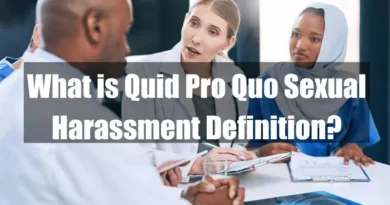Explaining Age-Oriented Quid Pro Quo Harassment
Takeaways
| Key Points |
|---|
| Age-oriented quid pro quo harassment is a form of workplace discrimination where individuals face pressure from supervisors to comply with demands in exchange for career benefits or to avoid negative consequences, often based on age-related biases. |
| This issue primarily affects older employees, who may be encouraged to take early retirement through severance offers, pension incentives, or reduced responsibilities, with implicit threats of termination or exclusion if they refuse, though younger workers can also experience coercion through excessive workloads or unreasonable demands tied to promotion opportunities. |
| Manifestations include promotion manipulation, where older employees may be required to train younger colleagues under the threat of losing career advancement, and younger employees may be pushed into roles beyond their scope to gain favor. |
| Addressing this type of harassment is challenging as it is often subtle, making it difficult for employees to recognize and document, particularly when age-related biases are framed as standard business decisions or workforce planning strategies. |
| Cultural and societal norms further complicate reporting, as older workers may feel obligated to retire when pressured, and younger workers may struggle to identify if workplace demands stem from age-based expectations or general employment dynamics. |
Introduction
Age-oriented quid pro quo harassment is a form of workplace discrimination where an individual is pressured to meet demands, typically by a supervisor, in exchange for career-related benefits or to avoid negative consequences based on their age. This type of harassment often targets older employees, who may be pushed toward early retirement or face other age-related pressures. While it shares similarities with sexual quid pro quo harassment, age-related cases are less frequently reported and discussed due to cultural and legal complexities surrounding age discrimination.
What is Quid Pro Quo Harassment?
Quid pro quo, a Latin term meaning “something for something,” involves an exchange where job benefits, like promotions or favorable assignments, are contingent on the employee complying with certain demands. Refusal often results in negative employment actions, such as demotion, poor performance evaluations, or even termination.
Manifestations of Age-Oriented Quid Pro Quo Harassment
Age-oriented quid pro quo harassment can manifest in various ways, typically through coercive tactics tied to employment conditions. Below are some scenarios that reflect common forms of this issue:
- Early Retirement Pressure: Employers may offer older employees severance packages or enhanced pension benefits to encourage early retirement. If the employee refuses, they might face negative repercussions such as exclusion from key projects, reduced responsibilities, or even termination. This tactic is commonly associated with age discrimination.
- Demands on Younger workers: While less commonly linked directly to age discrimination, younger employees might be pressured to work excessive hours, take on tasks outside their job scope, or perform menial duties in exchange for promises of promotion or favorable treatment. Failure to comply may result in being overlooked for promotions or receiving poor performance reviews.
- Promotion Manipulation: Both younger and older employees may experience promotion-related pressure tied to age-related expectations. For example, older employees might be encouraged to take on fewer responsibilities or to train younger colleagues, with the implicit threat of being passed over for promotions if they do not comply. This is often part of a broader strategy to phase out older workers.
Challenges in Addressing Age-Oriented Quid Pro Quo Harassment
Age-related harassment often goes unreported for several reasons. First, age-based harassment is more subtle than sexual harassment or overt discrimination, making it difficult for employees to recognize and document. For instance, older employees may be told they are “outdated” or “no longer a fit for the organization,” which could be interpreted as standard business decisions rather than harassment.
Similarly, younger workers may feel pressured to conform to supervisors’ demands, though they might not immediately recognize if these demands are shaped by age-related expectations or broader workplace dynamics.
Additionally, age-related societal norms and expectations may prevent employees from speaking up. For example, older workers may feel obligated to retire when asked, believing it is “time to move on,” even though the request itself is discriminatory.
Preventing Age-Oriented Quid Pro Quo Harassment
Employers can implement several strategies to prevent age-oriented quid pro quo harassment. These include:
- Anti-Harassment Policies: Clear policies that define and prohibit all forms of quid pro quo harassment, including age-related ones, should be in place. This helps employees understand their rights and recognize when age-related demands cross the line into harassment.
- Training Programs: Regular training for supervisors and employees on identifying and preventing age-based harassment can raise awareness and encourage reporting. Training should include guidance on what constitutes inappropriate age-based comments or requests, ensuring that workers of all ages are treated fairly.
- Effective Reporting Channels: Providing employees with confidential, accessible channels for reporting harassment ensures that incidents are documented and addressed promptly. Employers should make it clear that no employee will face retaliation for reporting age-oriented harassment.
- Inclusive Work Culture: Encouraging a workplace culture that values diversity across all ages can prevent discriminatory practices. Recognizing the contributions of both younger and older workers fosters a more inclusive environment and reduces the likelihood of age-based harassment.
Conclusion
Age-oriented quid pro quo harassment is a serious yet underreported form of workplace discrimination. It affects employees across the age spectrum, from younger workers being coerced into accepting unfavorable conditions to older workers being forced out or pressured into early retirement.
As awareness grows, employers must implement effective anti-harassment policies that explicitly include age-related protections to foster a fair and inclusive work environment.
FAQ
What is Age-Based Quid Pro Quo Harassment?
Age-Based Quid Pro Quo Harassment refers to a form of misconduct in which job benefits or professional opportunities are contingent upon compliance with age-related requests or demands. This unethical practice exploits age as a factor in professional decision-making, thereby undermining merit-based advancement and fostering an imbalanced power dynamic in the workplace.
How does Age Discrimination in Quid Pro Quo occur?
Age Discrimination in Quid Pro Quo occurs when decision-makers impose conditions for career benefits that are intrinsically tied to an employee’s age rather than professional competence. This results in a discriminatory environment where age becomes an undue factor in determining job-related rewards and opportunities.
What is Generational Bias in Workplace Harassment?
Generational Bias in Workplace Harassment involves imposing negative stereotypes or expectations based solely on an employee’s age group, which then influences professional treatment and opportunities. This bias not only marginalizes individuals but also disrupts organizational cohesion by favoring certain generational traits over objective performance.
How does Age Exploitation in Quid Pro Quo Scenarios work?
Age Exploitation in Quid Pro Quo Scenarios manifests when those in power manipulate age-related norms to coerce employees into agreeing with unethical or unwanted conditions in exchange for workplace benefits. Such exploitation leverages societal perceptions about age to create a coercive environment that distorts fair professional advancement.
What is Seniority Coercion in Age-Based Harassment?
Seniority Coercion in Age-Based Harassment occurs when an employer or supervisor misuses an employee’s tenure or perceived experience as leverage to demand compliance with age-specific conditions. This tactic not only undermines the principles of fair treatment but also pressures employees to conform to inappropriate requests in order to maintain their status or opportunities.
What does Age Profiling in Quid Pro Quo Claims mean?
Age Profiling in Quid Pro Quo Claims refers to the practice of making generalized assumptions about an individual’s capabilities or work ethic based solely on their age, which is then used to justify conditional employment benefits. Such profiling distorts objective assessments by replacing them with biased expectations, leading to unfair treatment in professional settings.
What is Generational Pretext Harassment?
Generational Pretext Harassment is when age differences are used as a superficial justification for imposing conditions that may not be related to actual job performance. This approach disguises discriminatory practices under the guise of addressing intergenerational differences, thereby facilitating biased treatment within the organization.
How do Age-Specific Retaliatory Practices manifest?
Age-specific retaliatory Practices manifest when employees who resist or reject age-related demands face punitive measures, such as demotion or exclusion from opportunities. These practices create a chilling effect that discourages individuals from contesting unfair conditions, thus perpetuating a cycle of discrimination and harassment.
What is Age Bias in Employment Quid Pro Quo?
Age Bias in Employment Quid Pro Quo involves conditioning job-related benefits or career advancement on an employee’s willingness to conform to age-oriented demands. This bias prioritizes age over merit, leading to environments where discriminatory practices overshadow professional qualifications.
How does Age-Oriented Reciprocal Coercion operate?
Age-oriented reciprocal Coercion operates through an exchange in which age-based concessions are demanded in return for professional benefits, creating an imbalanced power dynamic. This coercion disrupts equitable workplace practices by forcing individuals to negotiate under terms that are inherently biased by age.
What is Age-Based Conditional Advancement?
Age-Based Conditional Advancement refers to career progression that is unfairly contingent on meeting age-related criteria rather than based on merit or performance. This practice erodes the principles of equal opportunity by linking professional growth to personal attributes unrelated to job competency.
What is Age Discriminatory Quid Pro Quo Conduct?
Age Discriminatory Quid Pro Quo Conduct involves linking favorable employment outcomes directly to compliance with demands that target an employee’s age. This conduct subverts meritocracy by allowing age-related factors to dictate the distribution of opportunities, thereby fostering a discriminatory workplace culture.
How is Intergenerational Harassment Quid Pro Quo defined?
Intergenerational Harassment Quid Pro Quo is defined as coercive behavior where differences between age groups are exploited to impose unfavorable conditions or demands for professional benefits. This practice undermines collaborative efforts by pitting generational characteristics against one another and compromising fair treatment.
What are Age-Specific Exploitation Tactics?
Age-specific exploitation Tactics involve using an employee’s age as a leverage point to extract compliance or concessions in exchange for workplace rewards. These tactics exploit societal and organizational stereotypes about age, leading to coercive practices that detract from a fair and merit-based work environment.
What is Age-Sensitive Quid Pro Quo Manipulation?
Age-Sensitive Quid Pro Quo Manipulation is a form of exploitation where age is employed as a bargaining chip to negotiate favorable conditions or to avoid adverse consequences. This manipulation creates a coercive dynamic that skews professional evaluations and undermines the integrity of unbiased decision-making.









